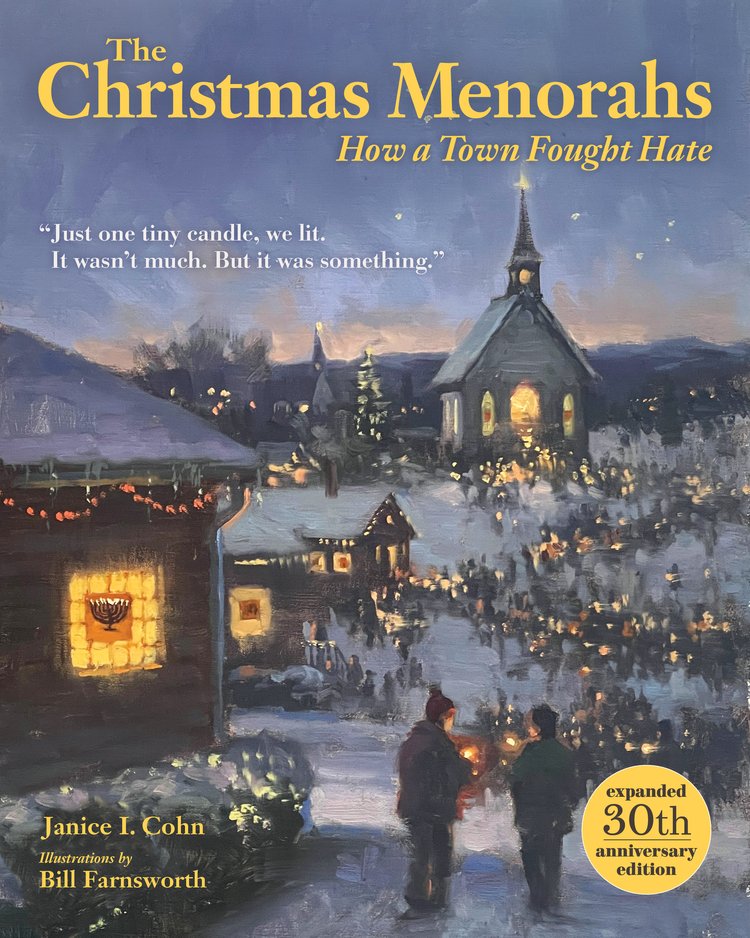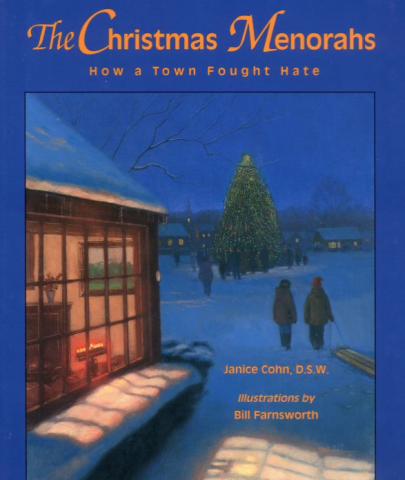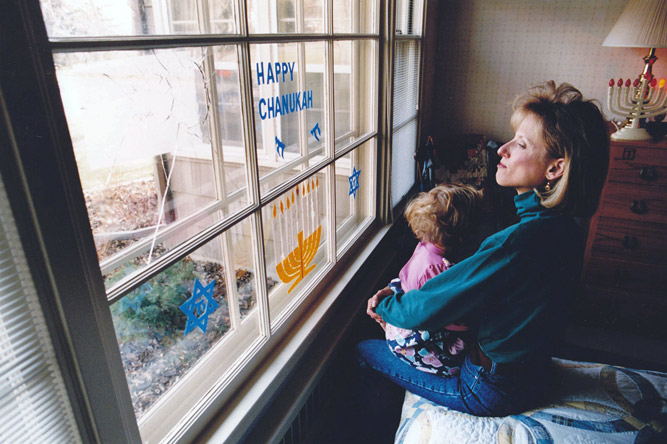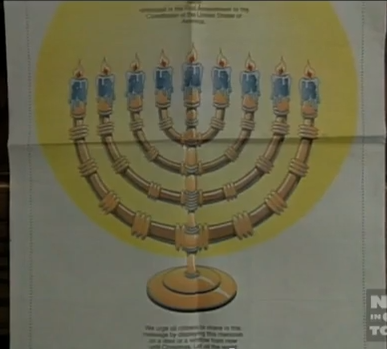 By Janice I. Cohn
By Janice I. Cohn
"These are some events—good and bad—that are hard for us to get out of our minds; they remain in the recesses of our psyches and often re-emerge when they have not been thought about for months or years, exerting a powerful effect on our actions and beliefs.
One such example, I believe, is the story of the 1993 events which took place in Billings, Montana. I wrote a book for young people describing those events, The Christmas Menorahs: How A Town Fought Hate (1995) and then, several years ago, adapted it into a play, Paper Candles: How Courage and Goodness Triumphed In An American Town.
We are all concerned that young people today are permeated with images of violence, divisiveness and general incivility, whether it comes from the internet, the T.V. screen or their everyday lives. But the good news is that young people’s capacity to be deeply moved and inspired by true stories of courage and goodness remains strong. I’ve seen this throughout the country as I’ve spoken with youngsters about Billings in their schools, churches and synagogues, and watched them re-enact those events through drama and song.
The story of Billings, Montana, is, in essence, several stories. It’s a story of a police chief who understood the seriousness of hate crimes and was determined they would not be tolerated under any circumstances; the story of a lay church leader who remembered a story she had heard as a child, which she then used to inspire her community; the story of clergy of all faiths who were committed to practicing what they preached and, finally, the story of town residents of many races, religions and backgrounds who were willing to fight for a basic principle despite the risk."
 |
| The Christmas Menorahs: How a Town Fought Hate by Dr. Janice I. Cohn, Illustration by Bill Farnsworth |
Bring this story about a community standing up to antisemitism and hate to your town this holiday season with the book and a movie. Learn more about the book: The Christmas Menorahs: How a Town Fought Hate. Not In Our Town is the half hour film that launched a movement to stop hate. Watch the full film here and share it with your family and friends.
 This is essentially what happened:
This is essentially what happened:
Billings began to be infiltrated by skinheads and members of racist groups in early 1993. Their exact number was hard to ascertain, but shortly after their arrival hate literature targeted toward Jews, blacks and other minorities began to be distributed.
Wayne Inman, chief of the Billings Police Department and Margaret MacDonald, executive director of the Montana Association of Churches, urged the town to react strongly and decisively to stop the hate mail. At first, many people thought it simply should be ignored and that focusing attention on the hatemongers would encourage them.
But Chief Inman and church leaders persisted and started a series of “teach-ins” throughout the community, focusing on educating people about the ultimate consequences of not taking a strong stand against hate crimes, even minor ones. At first, few people attended, but the attendance grew and ultimately involved a cross section of the entire community.
Though Chief Inman and the churches became the targets of a series of threats and attacks, they continued to act aggressively. Educators, human rights advocates and labor leaders joined Chief Inman and church leaders to form a community network that monitored and forcefully responded to hate speeches and acts of vandalism against minorities.
A full-page advertisement was published in the town newspaper, strongly condemning hatred and bigotry. More than 100 community organizations placed their names on the ad, as did thousands of ordinary residents, and a town rally was held to declare the moral equivalent of war against hate crimes of any kind.
10,000 Menorahs
Things seemed to settle down for a while, but several months later, as Christmas and Hanukkah approached, the town’s synagogue received a series of bomb threats and its small cemetery was desecrated. Shortly thereafter, two Jewish homes displaying menorahs were vandalized. In one case, a child’s bedroom window, which displayed a menorah, was shattered by a rock thrown during the night. It landed on his bed; had he been sleeping he would have been seriously hurt, or worse.
The child’s parents, Brian and Tammie Schnitzer, long active in the human rights community, spoke out eloquently and forcefully. Immediately, a network of church and community groups sprang into action. The Rev. Keith Torney, of the First Congregational Church, and Margaret MacDonald argued forcefully that a meaningful, symbolic gesture was needed along with efforts to apprehend the vandals.

Tammie Schnitzer sits in front of her son's window
Then, Ms. MacDonald had an idea. Inspired by stories she had heard about the 1943 rescue of the Danish Jews in Nazi occupied Denmark, by Christian Danes, she suggested that all Billings residents – Christians and Jews alike – display pictures of menorahs in their windows.
A short time later, hundreds of families and institutions displayed such pictures. At first, windows were broken in churches and schools and town residents received threatening phone calls. People had their cars and homes vandalized. But that only strengthened the town’s determination. Soon, thousands of menorahs were displayed throughout the town. The Billings Gazette printed a full-page color picture of a menorah and urged residents to display it on a door or in a window to show their solidarity in the fight against bigotry. Thousands more were soon displayed.

A major business in town replaced its regular advertisement on a prominent billboard with a message strongly condemning the hate crimes. Other businesses followed suit. Soon schools and churches began having discussions with children of all ages about the events that were occurring and the importance of fighting bullying and bigotry. Youngsters’ ideas were solicited and listened to. Many of the children had pictures of menorahs in their own windows and saw their churches and families taking action. Though they may not have ever met a Jewish or black child, they started to think and talk about how those children must feel about being the targets of hatred. Then they began to think about what they could do to help.
When it was time for Hanukkah services to be held in the tiny Billings synagogue, dozens and dozens of Christians came to worship with their Jewish neighbors. There was not enough room to accommodate all who came. Many people stood outside the synagogue, ready to protect the worshippers and the synagogue itself.
Eventually, the hate speech and acts of intimidation ceased. Rev. Torney explained what happened this way:
This is almost embarrassing. It’s not the Garden of Eden here. We have huge problems. But people are trying. I believe this could happen in any community… This town is a little smaller, the air is a little cleaner, but this is every place. It’s not unique here. If it is, we are all in big trouble. I think what happened with this whole menorah thing is that permission was given for people to be good. People are often told that but in this case we gave them a way to do it.
In the years since those events, communities across this country have been inspired by Billings. Young people who have heard the story, seen the PBS award-winning documentary, Not In Our Town, read my book and/or been involved in the play have also become actively involved in becoming “upstanders” and taking a stand against bullying and prejudice through the Not In Our Town movement.
Winston Churchill once said that courage is the virtue that makes all other virtues possible. This 20th anniversary of the events in Billings will hopefully prompt people to reflect not only on the importance of courage, but on the true meaning of the holidays: celebrating religious freedom and loving our neighbors as ourselves.
The fight against antiisemitism and other forms of bigotry continues, as evidenced by a front page article which recently appeared in The New York Times, “Swastiskas, Slurs and Torment in Town’s Schools.” Just think about the kind of world we would have if every town was like Billings.
Dr. Janice Cohn was inspired to write The Christmas Menorahs: How a Town Fought Hate after reading an article in The New York Times in 1994 and traveling to Billings, Montana, to find out what happened there. Convinced that the story is as timely today as it was thirty years ago, Dr. Cohn chose to reissue the original book with the addition of extra material to tell the world the story of Billings again and to motivate all of us to become upstanders in the face of injustice.Dr. Cohn is a psychotherapist who specializes in helping adults and children cope with grief, loss, and life transitions. Her former newspaper column for the Family Times section of The Washington Times, which focused on raising compassionate children, ran for over two years and reached approximately half a million people.
Learn more about the book: The Christmas Menorahs: How a Town Fought HateLearn more about Dr. Janice Cohn’s play Paper Candles and the events in Billings and Denmark at PaperCandles.com. Whether you view Not In Our Town, read The Christmas Menorahs, or view or perform Paper Candles, use this Discussion Guide from Dr. Cohn to open up a conversation about fighting bullying, hatred and intolerance.
Dr. Janice Cohn is a psychotherapist and writer. She speaks on a variety of topics focusing on instilling moral courage and compassion in young people. She can be reached directly at drjanicecohn@aol.com and her website address is DrJaniceCohn.com.
Comments
Although hate crimes and
Although hate crimes and violence was not an issue in Whitewater, Tennessee naievitee of minorities, Jews and, in particular, The Holocaust was evident. The wonderful approach by a Jr. High School Social Studies teacher and her Principal resulted in a terrific story and documentary of a town awakened by the courage of the teacher as well as by the motivational energy and involvement of the students..I refer to the documentary "PAPER CLIPS'.
Add new comment